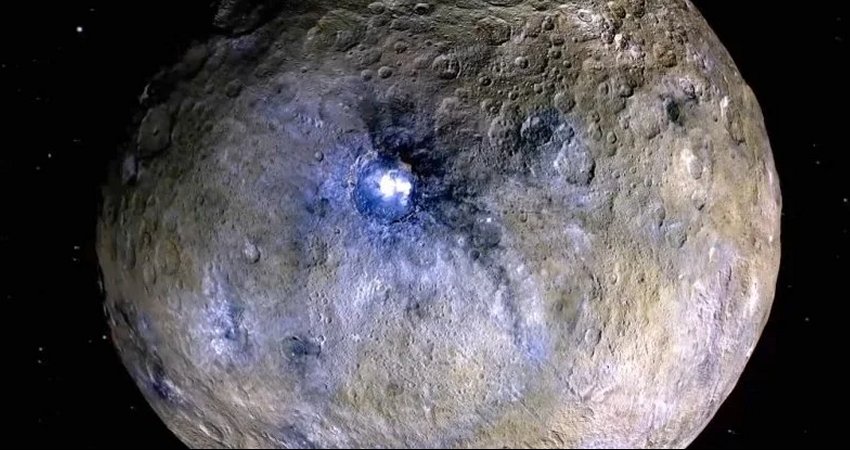Eddie Gonzales Jr. – MessageToEagle.com – Despite being called a dwarf, the importance of Ceres should not be underestimated because it is a very interesting object. Discovered by Italian polymath Giuseppe Piazzi in 1801, Ceres is the largest object in the asteroid belt between Mars and Jupiter.
Called an asteroid for many years, Ceres is so much bigger and so different from the rocky neighbors that scientists classified it as a dwarf planet in 2006. Even though Ceres comprises 25 percent of the asteroid belt’s total mass, tiny Pluto is still 14 times more massive.
Ceres is named for the Roman goddess of corn and harvests. The word cereal comes from the same name.

Dwarf planet Ceres. Credit: NASA
It has long been assumed Ceres is just a barren space rock, but NASA Dawn spacecraft has captured high-resolution images of its surface show Ceres is geologically active.
The results of a major exploration mission reveal dwarf planet Ceres is an ocean world with reservoirs of sea water beneath its surface.
A team of scientists from the United States and Europe has analyzed images relayed from the orbiter, captured around 35 kilometers (22 miles) from the asteroid.
They focused on the 20-million-year-old Occator crater and determined that there is an “extensive reservoir” of brine beneath its surface.
Using infrared imaging, one team discovered the presence of the compound hydrohalite—a material common in sea ice but which until now had never been observed off of Earth.
Maria Cristina De Sanctis, from Rome’s Istituto Nazionale di Astrofisica said hydrohalite was a clear sign Ceres’ used to have sea water.
“We can now say that Ceres is a sort of ocean world, as are some of Saturn’s and Jupiter’s moons,” she told AFP.
The team said the salt deposits looked like they had built up within the last two million years—the blink of an eye in space time.
This suggests that the brine may still be ascending from the planet’s interior, something De Sanctis said could have profound implications in future studies.
“The material found on Ceres is extremely important in terms of astrobiology,” she said.
“We know that these minerals are all essential for the emergence of life.”
Ceres is the largest object in the asteroid belt between Mars and Jupiter and has its own gravity. Credit: NASA
Scientists explain the discovery of hydrohalite was a “smoking gun” for ongoing water activity.
“That material is unstable on Ceres’ surface, and hence must have been emplaced very recently,” she said.
In a separate paper, US-based researchers analyzed images of the Occator crater and found that its mounds and hills may have formed when water ejected by the impact of a meteor froze on the surface.
The authors said their findings showed that such water freezing processes “extend beyond Earth and Mars, and have been active on Ceres in the geologically recent past”.
Written by Eddie Gonzales Jr. – MessageToEagle.com Staff






